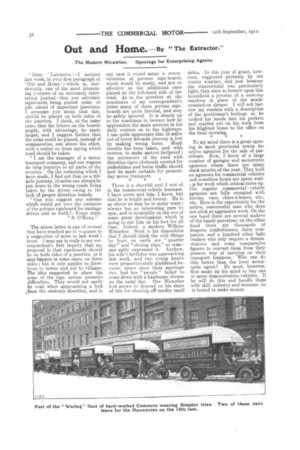Out and Home. By "The Extractor."
Page 12

If you've noticed an error in this article please click here to report it so we can fix it.
The Modern Micawber. Openings for Enterprising Agents.
"DustExtractor.'—1 noticed last week, in your first paragraph of 'Out and Home '—which is, incidentally, one of the most interesting features of an extremely interesting journal—that you advocate signboards being placed some 50 yds. ahead of important junctions. I presume you mean that the should be placed on both sides of the junction. I think, at the same time, that the letters on the boards might, with advantage, be made larger, and I suggest further that the arms could be placed, instead of compasswise, one above the other, with a notice on them saying which road should be taken.
"I am the manager of a motor transport company, and our wagons do long journeys to all parts of the country. On the reckoning which I have made, I. find out that on a 200mile journey, 10 miles can always be put down to the wrong roads being taken by the driver owing to the lack of proper direction boards.
"Can you suggest any scheme which would get over the nuisance of the private signboard for carriage drives and so forth I—Yours truly,
"S. O'HARA."
The above letter is one of several that have reached me in response to a suggestion of mine in last week's issue. I may say in reply to my correspondent's first inquiry that my proposal is that signboards should be on both sides of a junction, or it may happen in some eases, on three sides; but it only applies to directions to towns and not to villages. The idea suggested to place the arms of the sign across presents difficulties. They would not easily be read when approaching a fork from the contrary direction, and in any case it would mean a reconstruction of present sign-boards which would be costly, and not so effective as the additional ones placed on the left-hand side of the road. As to the question at the conclusion of my correspondent's letter many of these private signboards are quite farcical, and may be safely ignored. It is clearly up to the coachman to beware how he approaches the main arteries in his daily venture on to the highways. I can quite appreciate that 10 miles out of every 200-mile journey is lost by making wrong turns. Much trouble has been taken, and with success, to make motors foolproof ; the intricacies of the road with direction signs obviously erected for pedestrians and horse traffic should now be made suitable for presentday motor transport.
There is a cheerful soul I wot of in the commercial-vehicle business. I have never met him, I know, but that he is bright and breezy. He is as clever as may be in many ways ; always has an interesting yarn to spin, and is invariably on the eve of some great development which is going to put him on his feet for all time. Indeed, a modern Wilkins Micawber. Such is his disposition that I should think the only things he fears on earth are " quarter day" and "closing time," as someone aptly expressed it. Anyhow, his wife's birthday was approaching last week, and two young hearts were proportionately gladdened because. never since their marriage (NI,. had her " people" failed to come down with a handsome cheque on the natal day. Our Micawber lisd grown to depend on his share of this for clearing off sundry small debts. In this year of grace, however, suggested probably by the winter weather, and just because the wherewithal was particularly light, they elect to bestow upon this household a present of a mincing machine in place of the muchcounted-on cheque. I will not harrow my readers with a, description of the gentleman's feelings as he tucked his hands into his pockets and started out on his walk from his blighted home to the office on the fatal morning.
To my mind there is a great opening in most provincial towns for active agencies for the sale of parcelcars. Now, I know of a large number of garages and motorcycle agencies where there are many slack months of the year. They hold no agencies for commercial vehicles and countless hours are spent waiti ag for work which seldom turns up. The regular commercial vehicle agencies are fully occupied with lorries, vans, chars-a-belies, etc., etc. Here is the opportunity for the active, resourceful man who does not stick at aggressive work. On the one hand there are several makers of the handy parcelcar, on the other hand there are thousands of drapers, confectioners, dairy companies, and a hundred other light traders who only require a demonstration and some comparative figures to convert them from their present way of carrying on their transport business. Who can do this better than the local motorcycle agent? He must, however, first make up his mind to buy one or more demonstration vehicles. If he will do this and handle them with skill, industry and resource, he is bound to make money.




















